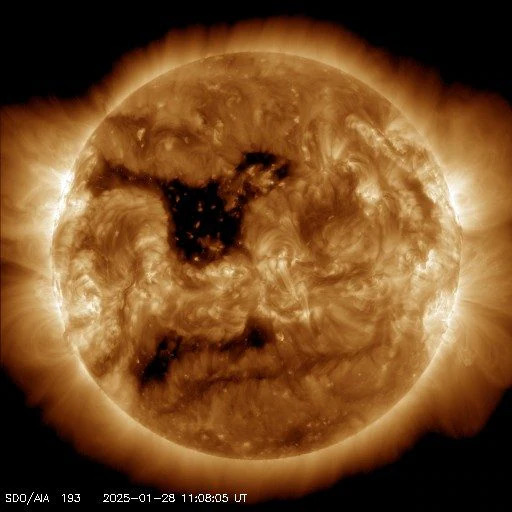Our Sun, the source of light and life, never ceases to amaze us. Recently, instruments aboard NASA's Solar Dynamics Observatory (SDO) captured spectacular images of a massive coronal hole appearing on the solar surface. This gigantic dark region, spanning approximately 800,000 kilometers in diameter, is sending a stream of solar wind toward Earth. But what does this mean for us? Let’s explore this fascinating cosmic phenomenon together.
What Are Coronal Holes?
Coronal holes are regions in the solar corona—the outermost layer of the Sun's atmosphere—where the magnetic field is open, allowing the solar wind to escape more freely. This makes them cooler and less dense compared to surrounding regions, which is why they appear as dark spots in images captured by space telescopes. Unlike sunspots, coronal holes are not associated with particularly violent solar flares, but they can still have effects on our planet.

Credit: NASA/SDO
The Impact on Earth
The stream of solar wind from this immense coronal hole is expected to reach Earth by January 31. However, according to expert forecasts, its impact should be limited. It is predicted to cause at most a G1-class geomagnetic storm, the weakest on a scale that goes up to G5. This means minimal effects, with possible minor disruptions to radio communications and some spectacular aurora borealis displays visible at lower latitudes than usual.
The Sun and Its Activity Cycle
The Sun follows an 11-year magnetic activity cycle, and it is currently at its solar maximum, a period when phenomena like coronal holes, sunspots, and coronal mass ejections (CMEs) become more frequent. Despite this, on January 27, the Sun temporarily lost its sunspots, an unusual event that scientists are closely monitoring.
A Future of Solar Storms?
Although the current coronal hole does not pose a significant threat, experts warn that the Sun may produce more intense geomagnetic storms in the coming months. In particular, more powerful coronal mass ejections (CMEs) could have a stronger impact on Earth's technological infrastructure, including satellites, power grids, and communication systems. Some of these events could even make the aurora borealis visible in Italian skies.
Observing phenomena like coronal holes reminds us how dynamic and unpredictable our Sun truly is. While the stream of charged particles arriving on January 31 does not pose a direct threat, it is always fascinating to see how our star influences Earth. We will continue to monitor solar activity closely, ready to be amazed once again by its incredible manifestations.
For further insights, visit: NASA - Coronal Holes and Fast Solar Wind








Leave a Comment